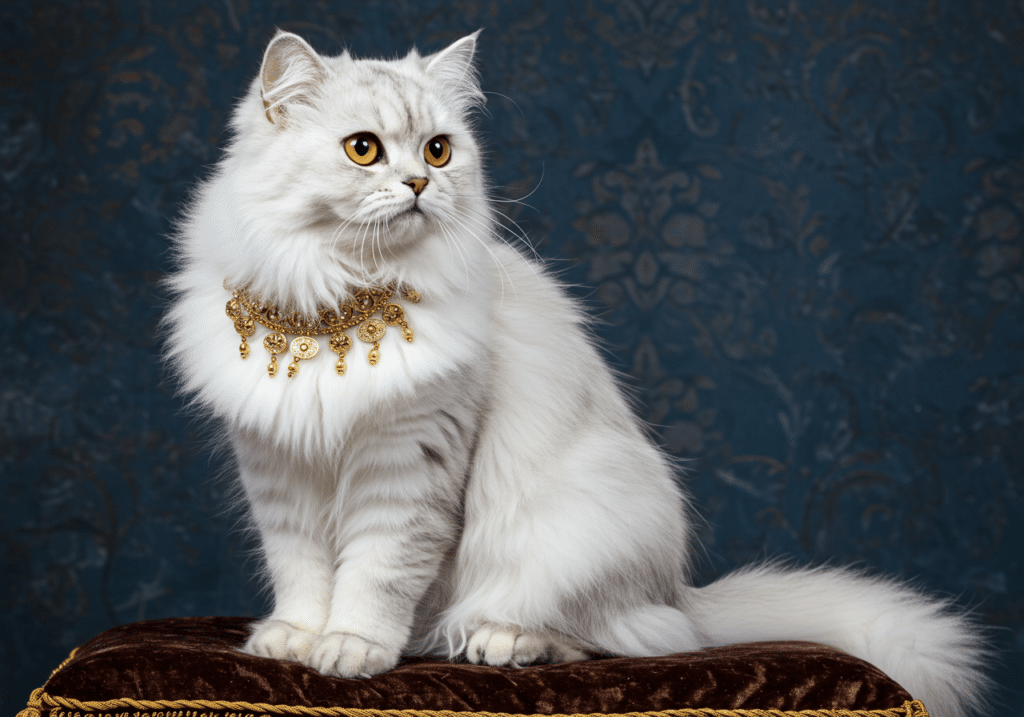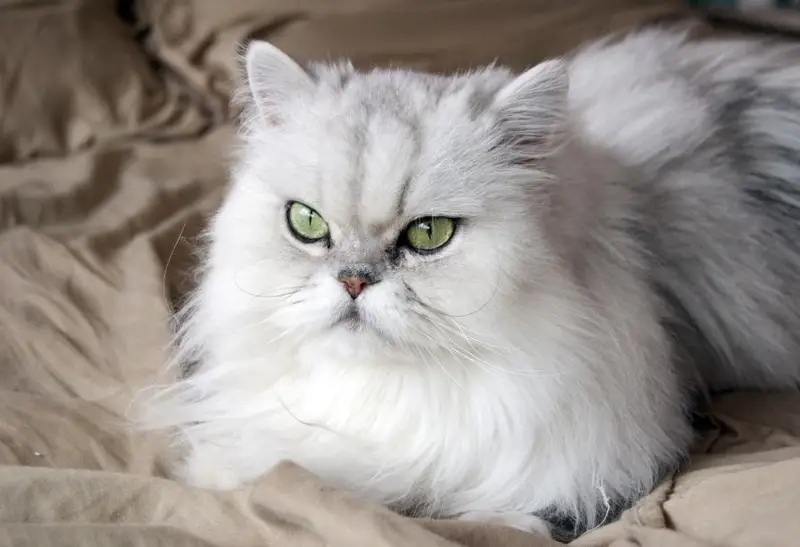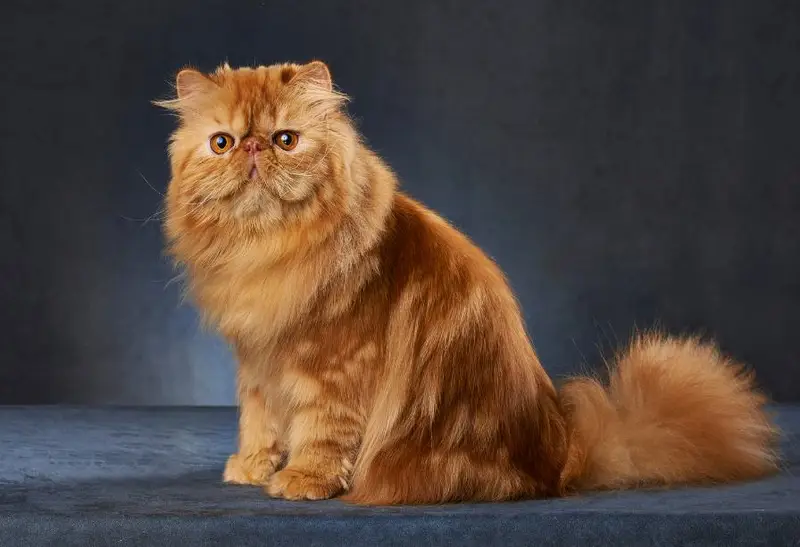Persian cats stand as one of the most distinguished and cherished breeds in feline history. Their remarkable characteristics and gentle nature have earned them a special place in households worldwide.


Table of Contents
Understanding Persian Heritage
Ancient Origins
The Persian cat’s story begins in the cradles of ancient civilization. Archaeological evidence traces their lineage back to the palaces of ancient Persia, where these magnificent felines evolved from desert dwellers to sophisticated companions. These cats first emerged in the dusty landscapes of ancient Mesopotamia, where their long coats developed as protection against harsh desert conditions.
Modern Evolution
The late 1950s marked a significant transformation in Persian cat breeding practices. A notable genetic mutation led to the development of the “peke-faced” Persian, named after the flat-faced Pekingese dog. This variation significantly influenced the breed’s modern appearance.

Contemporary Persian cats display more pronounced features compared to their ancestors, particularly in facial structure. This transformation, known as “extreme-” or “ultra-typing,” has created the distinctive flat-faced look that characterizes modern Persians. Some breeders maintain traditional Persian lines, preserving the more pronounced muzzle of the original breed type.
Physical Characteristics
Distinctive Features
Persian cats showcase a medium-to-large build with a muscular, heavy-boned structure. Their distinctive features include a broad chest, short neck, and large shoulders, creating their characteristically sturdy appearance.
Facial Features
The breed’s most recognizable trait is the flat face with full cheeks and a short snub-nose. Their sweet expression comes from:
- Large, round, wide-set eyes
- Short muzzle
- Medium-sized ears
- Firm chin
Size and Structure
Persian cats typically measure:
- Height: 25-38 cm
- Weight: 4-8 kg
- Males are generally larger than females
Coat Variations
Their signature long, thick coat features a dense undercoat and comes in numerous colors and patterns:
| Color Types | Pattern Types |
|---|---|
| Black, White, Blue | Tabby |
| Cream, Red, Lilac | Tortoiseshell |
| Silver, Golden | Solid |
| Chocolate | Bicolor |
AMAZING FACT: Persian cats’ eye colors naturally complement their coat colors, with solid-colored cats typically displaying dark blue or copper eyes, while Chinchilla Persians showcase green or blue eyes!
Personality Profile
Temperament Traits
Persian cats embody a gentle, calm disposition that sets them apart in the feline world. Their peaceful nature makes them ideal companions for those seeking a serene pet relationship. These cats display a perfect balance of quiet affection and dignified independence.
Understanding Persian Cat Ownership
For a comprehensive look at what to expect when living with a Persian cat, watch this detailed guide that covers both the rewards and challenges of Persian cat companionship:
This informative guide explores the multifaceted nature of Persian cats, from their gentle, laid-back personality to their specific care requirements. It provides valuable insights for both prospective and current Persian cat owners, helping them understand what makes these elegant felines unique companions.
Social Dynamics
While naturally reserved with strangers, Persian cats form deep bonds with their chosen family members. They showcase their affection through:
- Sweet, musical vocalizations when communicating needs
- Gentle greetings upon their owner’s return
- Contented purring during lap time
| Trait | Level | Description |
|---|---|---|
| Affection | High | Loving with family members |
| Energy | Low | Prefers relaxed activities |
| Intelligence | High | Smart but deliberately paced |
| Vocalization | Low | Quiet but communicative |
| Sociability | Medium | Selective with companionship |
Living Compatibility
Persian cats excel in calm environments with predictable routines. Their adaptable nature allows them to thrive in various living situations, from quiet senior households to families with respectful children. They appreciate companionship but also enjoy independent time, making them suitable for working households.
MUST KNOW: While Persian cats can adapt to busy households, they show their best personality traits in peaceful environments where they can maintain their dignified demeanor!
Health Considerations
Common Health Issues
Persian cats require vigilant health monitoring due to their unique physical characteristics. Their distinctive features can lead to several breed-specific conditions that need regular attention.
| Health Concern | Description | Prevention |
|---|---|---|
| Polycystic Kidney Disease (PKD) | Inherited condition causing kidney cysts | Genetic testing before breeding |
| Brachycephalic Syndrome | Breathing difficulties due to flat face | Temperature control, avoid overexertion |
| Dental Disease | Prone to tartar buildup and misalignment | Regular brushing, dental check-ups |
| Eye Problems | Excessive tearing and infection risk | Daily cleaning, regular checks |
| Heart Disease | Risk of hypertrophic cardiomyopathy | Regular veterinary screening |
| Seborrhea | Skin and coat issues | Regular grooming, proper nutrition |
Preventive Care
Regular veterinary check-ups and early intervention prove essential for maintaining a Persian cat’s health. Key preventive measures include:
- Genetic testing for PKD
- Regular dental cleanings
- Temperature-controlled environment
- Eye and facial hygiene maintenance
- Proper grooming routine
AMAZING FACT: While Persian cats face unique health challenges, proper preventive care can help them live healthy lives spanning 15-20 years!
Grooming Requirements
Daily Maintenance
Persian cats require meticulous grooming routines to maintain their luxurious double coat. A systematic approach ensures both beauty and health:
| Task | Frequency | Technique |
|---|---|---|
| Brushing | Daily | Work in sections from head to tail |
| Face cleaning | Daily | Gentle wiping of eyes and facial folds |
| Combing | Daily | Metal wide-toothed comb for undercoat |
| Bathing | Every 3-4 weeks | Cat-specific shampoo and thorough drying |
Problem Areas
Special attention must be given to specific areas prone to matting:
- Behind the ears
- Under the chin
- Stomach region
- Underneath legs
- Armpits
- Chest area
Professional Care
Regular professional grooming sessions complement home care:
- Deep cleaning every 6-8 weeks
- Sanitary trimming as needed
- Professional dematting when required
- Nail trimming and ear cleaning
AMAZING FACT: Persian cats possess the densest fur among all cat breeds, with their coat requiring up to 30 minutes of daily grooming to maintain its signature lustre and prevent health issues!
Essential Tools
A complete grooming kit includes:
- Metal wide-toothed comb
- Slicker brush with steel pins
- Dematting tool
- Cat-specific shampoo
- Facial cleaning supplies
- Anti-static spray
Living Environment
Indoor Setup
Persian cats thrive in controlled indoor environments that cater to their specific needs. A well-designed living space includes:
| Essential Feature | Purpose | Requirements |
|---|---|---|
| Resting Areas | Comfort zones | Multiple cushioned spots at various heights |
| Water Stations | Hydration access | Cat fountains instead of bowls |
| Climbing Spaces | Exercise and observation | Cat trees and window perches |
| Grooming Station | Maintenance area | Well-lit, quiet corner |
| Litter Area | Sanitation | Clean, easily accessible locations |
Environmental Enrichment
Creating an engaging indoor space requires:
- Multiple scratching posts (both vertical and horizontal)
- Interactive toys for mental stimulation
- Designated observation perches near windows
- Temperature-controlled rooms
- Clean, draft-free spaces
Safety Considerations
Indoor living protects Persian cats from:
- Respiratory challenges
- Coat damage and matting
- Potential theft
- Disease exposure
- Weather-related stress
AMAZING FACT: Persian cats adapt exceptionally well to indoor environments, with studies showing they maintain better health and longer lifespans when kept exclusively indoors!
Dietary Needs
Nutritional Requirements
Persian cats require a carefully balanced diet that emphasizes protein and moisture content. Their unique facial structure and predisposition to certain health conditions necessitate special dietary considerations.
| Nutrient | Requirement | Purpose |
|---|---|---|
| Protein | Up to 50% of diet | Muscle maintenance and growth |
| Moisture | High content | Kidney health support |
| Fats | Moderate amounts | Energy source |
| Carbohydrates | Minimal | Natural carnivorous diet |
Feeding Guidelines
A proper feeding regimen includes:
- Combination of wet and dry food
- Regular feeding schedule
- Fresh water is always available
- Elevated feeding dishes for comfort
Special Considerations
Persian cats benefit from:
- High-quality protein from animal sources
- Moisture-rich wet food options
- Limited carbohydrate intake
- Omega fatty acids for coat health
Feeding Schedule
Establishing consistent meal times promotes healthy eating habits and supports their need for routine.
Key aspects include:
- Fixed feeding times
- Measured portions
- Regular water changes
- Clean feeding areas
AMAZING FACT: Persian cats process nutrients differently from other breeds. Studies show they need up to 90% of their daily calories from animal protein and fat to maintain optimal health!
Training & Enrichment
Training Fundamentals
Persian cats respond best to gentle, consistent training methods in peaceful environments. Their calm nature requires specific approaches for successful learning:
| Training Method | Application | Benefits |
|---|---|---|
| Positive Reinforcement | Treats and praise | Builds confidence |
| Clicker Training | Sound association | Clear communication |
| Hand Signals | Visual cues | Non-verbal direction |
| Voice Commands | Gentle tones | Verbal bonding |
Training Tips
Successful Persian cat training requires:
- Brief, focused sessions
- Consistent daily routines
- Peaceful training environment
- Early training initiation
- Patient, gentle approach
Enrichment Activities
Creating engaging experiences through:
- Interactive toy sessions
- Gentle puzzle feeders
- Window watching stations
- Scent exploration games
- Comfortable climbing spaces
AMAZING FACT: Persian cats excel in training when sessions are kept short and sweet. Research shows that consistent 5-minute sessions yield better results than longer training periods!
Family Compatibility
Household Dynamics
Persian cats excel in various family settings, showcasing remarkable adaptability to different household environments. Their gentle nature makes them particularly suitable for both quiet and active homes.
| Compatibility | Level | Notes |
|---|---|---|
| Children | High | Patient with gentle handling |
| Other Pets | Good | Non-territorial nature |
| Seniors | Excellent | Calm companionship |
| Working Families | Moderate | Need regular attention |
| Multi-Pet Homes | Positive | Adaptable to other animals |
Social Characteristics
Persian cats demonstrate exceptional social traits:
- Tolerant of household noise
- Patient with handling
- Non-aggressive nature
- Gentle playfulness
- Quiet vocalizations
Special Considerations
Living with Persian cats requires:
- Regular family interaction
- Consistent daily attention
- Gentle handling guidelines
- Supervised child interactions
- Structured family routines
AMAZING FACT: Persian cats show remarkable tolerance levels with children, making them one of the few breeds that studies confirm as excellent family companions!
Frequently Asked Questions
What dietary considerations are essential for Persian cats?
Persian cats require premium cat nutrition with adequate moisture content and easily digestible proteins.
How frequently should Persian cats receive professional grooming?
Persian cats demonstrate excellent compatibility with children who understand and respect their gentle nature.
What health issues commonly affect Persian cats?
Regular monitoring for respiratory conditions, eye health, and PKD symptoms proves essential.
What grooming tools work best for Persian cats?
Professional-grade metal combs and specialized brushes designed for long-haired breeds yield optimal results.
How can Persian cats be protected from common environmental stressors?
Creating a calm indoor environment with controlled temperature and multiple resting areas ensures optimal comfort.
Conclusion
Persian cats represent the epitome of feline elegance and companionship. While their care requirements demand dedication, the rewards of sharing life with these magnificent creatures prove immeasurable. Through proper care, nutrition, and attention, Persian cats flourish as cherished family members, carrying forward their noble heritage with grace and dignity.
AMAZING FACT: Studies demonstrate that well-cared-for Persian cats consistently rank among the most affectionate and loyal companion animals!
